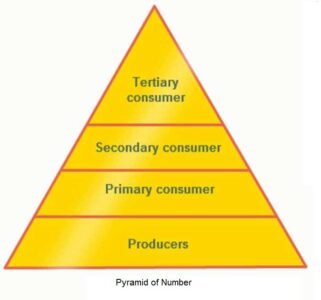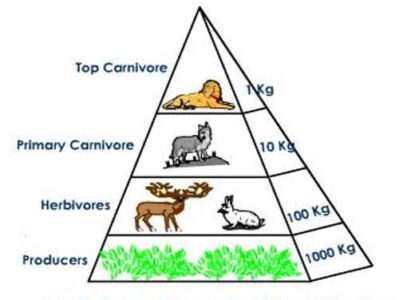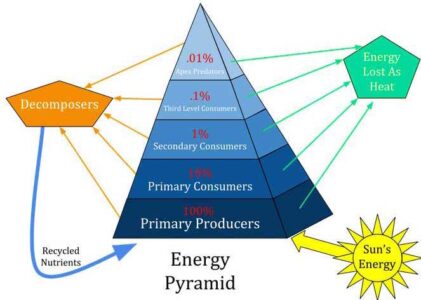G. Evylen Hutchinson and Raymond Lindeman first discovered the ecological pyramid. They graphically presented the definite relationship between the various forms of organisms such as producers and consumers at different trophic levels and made the graphical presentation which looks like a pyramid. In this case, the producers make up the base and the successive level of consumers constitute the upper layers.
Ecological pyramids are of the following three types:
- Pyramid of number: In this case, the number of individual organisms is taken into account;
- Pyramid of biomass: In the case, total dry weight of living materials are considered;
- Pyramid of energy: In this case, the rate of flow of energy at successive trophic level is taken into consideration;
Pyramid of Number
The pyramid of number is upright when the producer organisms remain in abundance near the base of food chain and the consumers gradually decrease in numbers towards the apex. Hence, in such situations the number of producer organisms is always more than that of the primary consumers indicating the relationship in numbers between the different trophic levels.
The number of consumers decreases in the successive levels of pyramids from below upwards. The pyramid of number may be inverted if the producer organisms are larger than the consumers in size as in forests.

Pyramids of Biomass
Pyramids of biomass may be either upright or inverted. This pyramid indicates the total living weight of each trophic level belonging to a particular food chain of any ecosystem.
The main feature of the pyramid of biomass is the indication of the gradual decrease in biomass in the trophic level from base towards the apex. In the forest ecosystem, the pyramid of biomass is upright and inverted in case of parasites.

Pyramid of Energy
The representation of energy flow in an ecosystem with the help of pyramid is called as the pyramid of energy. Energy pyramid is sometimes known as ecological or trophic pyramid. The trophic level at the base denotes the position of the highest amount of energy whereas the amount of energy at the trophic level situated at the apex is the lowest.
Pyramid of energy always remain upright as a gradual decline of energy takes place from the initiation to the termination of a food chain. Actually, it helps to transfer energy from one to another organism along the food chain. In this case, rate of energy level reduces from the bottom to the top of the pyramid through the trophic level.

For example, of about 20% of the total solar energy is used up by the green plants in the photosynthesis mechanism which they perform. It decreases in energy from lower to higher trophic levels during respiration.
Again energy is transmitted from one trophic level to the other 80% -90% of the potential energy is lost in the form of heat energy. Hence, pyramid of energy always remains upright while a gradual decline of energy takes place from the starting point to the termination of food chain.
Advantages of the Pyramid of Energy
- It assesses the pace of production over some period of time.
- Two types of alike biomass may have very diverse life spans. Thus, a direct relationship of their total biomasses is confusing, but their productivity is exactly comparable.
- The comparative energy chain inside a biological system can be looked at utilizing pyramids of energy; additionally various ecosystems can be compared.
- There are no reversed pyramids.
- The contribution of sun based energy or solar power can be included.
Disadvantages of Ecological Pyramid
- The pace of biomass production of the creature is required, which includes estimating growth and propagation through time.
- There is still the trouble of allocating the creatures to a particular trophic level. Just as the living things in the food chains there is the issue of allocating the decomposers and detritivores to a specific trophic level.
Significance of Ecological Pyramid
The significance of ecological pyramid can be clarified in the following focuses:
- They show the taking care of various living beings in various environments.
- It shows the proficiency of transfer of energy.
- The state of the ecosystem can be observed, and any further harmful activities can be prohibited.
- More than one organism may involve in various trophic levels as if there should be an occurrence of the food web. Along these lines, this system doesn’t consider food webs.
- The saprophytes are not measured in any of the pyramids despite the fact that they make a significant piece of the different ecosystem.
- These pyramids are relevant just to basic food chains, which for the most part don’t happen naturally.
- These pyramids don’t convey any idea according to varieties in season and atmosphere.
- They don’t think about the possibility of similar species at various levels.
- Trophic level denotes a functional level.
- A given species may involve more than one trophic level in a similar ecological system simultaneously.
- In most ecological systems, all the pyramids of biomass, number, and energy are upstanding. In this case, producers are more in biomass and number than the herbivores while herbivores are more in biomass and number than carnivores.
- Also energy at lower trophic level is in every case more at higher trophic level.
